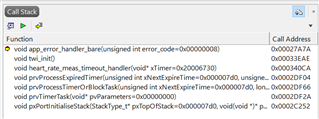Hello! I am trying to modify the ble_app_hrs_freertos example to send actual heart rate sensor value to the nRF Toolbox app over BLE. I am able to read values from my sensor through TWI, and I am also able to run the ble_app_hrs_freertos example and send the simulated data through BLE. Now, I would like to combine the two, and send the actual reading from the sensor to the app through BLE.
I tried modifying the heart_rate_meas_timeout_handler function of the code to take value from the sensor instead of sensorsim_measure(). However when I do this, I am not able to the device anymore. After trying different things, I realized that the nrf_drv_twi_tx() and nrf_drv_twi_rx() function is the issue. My I wrong to call nrf_drv_twi_tx() and nrf_drv_twi_rx() in the handler? How then, can I get the sensor reading through TWI?
static void heart_rate_meas_timeout_handler(TimerHandle_t xTimer)
{
static uint32_t cnt = 0;
ret_code_t err_code;
uint8_t heart_rate;
UNUSED_PARAMETER(xTimer);
//heart_rate = (uint16_t)sensorsim_measure(&m_heart_rate_sim_state, &m_heart_rate_sim_cfg);
heart_rate = readHRS();
cnt++;
err_code = ble_hrs_heart_rate_measurement_send(&m_hrs, heart_rate);
if ((err_code != NRF_SUCCESS) &&
(err_code != NRF_ERROR_INVALID_STATE) &&
(err_code != NRF_ERROR_RESOURCES) &&
(err_code != NRF_ERROR_BUSY) &&
(err_code != BLE_ERROR_GATTS_SYS_ATTR_MISSING)
)
{
APP_ERROR_HANDLER(err_code);
}
// Disable RR Interval recording every third heart rate measurement.
// NOTE: An application will normally not do this. It is done here just for testing generation
// of messages without RR Interval measurements.
m_rr_interval_enabled = ((cnt % 3) != 0);
}
void readHRS(uint8_t * read_long_data){
ret_code_t err_code;
err_code = nrf_drv_twi_tx(&m_twi_nrf52, HRS_ADDR, (uint8_t *) HRS_FIFO_DATA, sizeof(HRS_FIFO_DATA), true);
if (NRF_SUCCESS == err_code){
err_code = nrf_drv_twi_rx(&m_twi_nrf52, HRS_ADDR, (uint8_t *) read_long_data, 6);
}
APP_ERROR_CHECK(err_code);
nrf_delay_ms(10);
}
THANK YOU!



